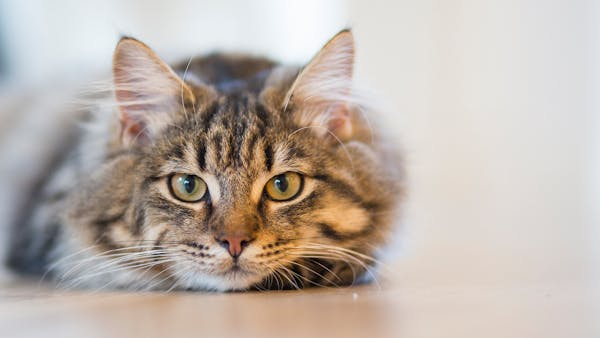Cats loaf. Loaf boat. Potato cat. At this point, you have probably heard many different variations of a very particular way that your furry friend sits. Because of the internet and our international and unending love of all things cat, we have all seen cat loaves and we are all in love with them.
Yes, the phenomenon of the "cat loaf" is one of the most adorable and also peculiar behaviors seen by our feline friends. If you’ve ever owned a cat or spent time around them, you’ve definitely seen this one of a kind and cute posture from your furry friend. It features a cat sitting with its paws and tail neatly tucked underneath its body, resembling a loaf of bread, hence the name that has spread like wildfire across the web.
This unique position has earned the nickname "cat loaf" among cat enthusiasts, and it’s a behavior that creates a mix of both curiosity and delight. It's cute, yes, but what does it mean and why does it happen? Many people wonder what exactly a cat loaf is, and why do cats do it? To understand this special and precious behavior, we must dig deeply into the world of feline bodies, their instincts, and their psychology.
At its core, the cat loaf is a comfortable resting position where a cat sits with its front paws folded underneath its chest and its hind legs tucked beneath its body. The tail is often wrapped around the side or tucked under their rounded edges as well, completing the loaf-like appearance. This posture is not only visually appealing but also serves several practical purposes for the cat. To fully appreciate the cat loaf, we need to explore the reasons behind it, which range from comfort and warmth to instinctual behaviors rooted in a cat’s evolutionary history.
Why Do Cats Loaf?
One of the explanations for the cat loaf is all because of the comfort that it brings a feline. We all know that cats are animal masters of finding cozy and efficient ways to rest, and the loaf position allows them to relax while maintaining a compact and secure posture.
By tucking their paws and tail underneath their body, cats minimize their exposure to the environment, creating a sense of warmth and protection. They are able to find a comfortable body temperature through "loafing" and it's also very easy on their joints and bodies.
This is very important for cats because they are inclined to conserve body heat. Unlike us humans, who can regulate their temperature through sweating or adding layers of clothing, cats always rely on their fur and body posture to maintain warmth. The loaf position helps them keep their heat by reducing the surface area exposed to cooler air, making it an ideal resting pose, specifically in colder environments like when they are lounging outside.
In addition to the comfort and warmth it brings, the cat loaf position is also all about a cat's need for safety and vigilance at all times. While many cat owners use calming supplements to provide their felines with peace of mind, nothing does the job better than a cat loaf position.
Cats are both predators and prey when they are out in the wild, and this split role has impacted and influenced many of their behaviors, including how they rest and find peace and calm. When a cat sits in the loaf position, it is able to stay very still while keeping its muscles slightly engaged. This means they are ready to react at a moment's notice.
Because of the cat's loaf position, the cat can spring into action quickly when needed, whether to pounce on prey or escape from a potential threat. The tucked-in posture also protects the most vulnerable part of the cat’s body: its belly, which is a sensitive area that predators might target. By keeping their limbs close to their body, cats are able to shield their abdomen while maintaining a low profile.
The Flexibility of the Cat Loaf
The cat loaf also highlights the incredible flexibility and agility of felines.
Cats are known for their supple spines and powerful muscles, which enable them to contort their bodies into a variety of positions. Their loafing posture is a key sign of their flexibility because it requires a cat to fold its limbs neatly beneath its body without discomfort. This ability to curl up compactly is not just a practical tool but it also serves as a reminder of the cat’s adaptations through the years via evolution.
Out in the wild, small cats and their forefathers and ancestors needed to squeeze into tight spaces for shelter or to stalk their prey, and the loaf position is a major part of this inclination to stay compact and agile at all times.
Another fascinating aspect of the cat loaf is its connection to a cat’s emotional state. Anyone who has owned one knows that cats of all breeds happen to be highly sensitive and emotional creatures. They don't hide what they are feeling, and they will let their emotional state be known. Their body language often provides key insight into their mood and the level of comfort they are feeling.
When a cat assumes the loaf position, it is usually a sign that they feel safe and relaxed in their environment or with the people they are around.
A cat that is anxious or on high alert is more likely to sit upright with its paws ready for action or to crouch low to the ground in a defensive posture. Meanwhile, the loaf also suggests a sense of trust and contentment. It’s a way for the cat to signal that it feels secure enough to let its guard down and rest without fear.
Communication of the Cat Loaf
Interestingly, the cat loaf can also serve as a form of communication between cats and their human owners or companions. Cats are very good at reading human body language and responding to our cues, and they often use their own body language to convey messages to us.
When a cat chooses to loaf in your presence, you should remember that it may be sending off a sense of comfort and trust in your relationship. This is obviously a good thing, especially from this animal that doesn't always like to be affectionate. Cat loafing is a subtle but meaningful gesture that reinforces the bond between cat and owner.
Additionally, the loaf position can be an invitation for interaction or playing. A cat that feels generally safe and relaxed may be more open to petting or affectionate attention, making the loaf a heartwarming moment for both parties.
While the cat loaf is usually associated with relaxation and contentment, it’s also always important to remember that not all loafing behavior is the exact same. Some cats may adjust their posture slightly depending on their surroundings and mood. For example, a cat that is loading but keeping its head upright and ears forward may still be somewhat alert, while a cat that is resting its head on its paws is probably in a deeper state of relaxation. Knowing all of these slight and important variations gives valuable insights into a cat’s emotional state and also helps owners understand their adorable and lovely little furry companions.
The cat loaf is also a behavior that transcends age and breed. Whether you have a playful kitten, a dignified senior cat, or someone fluffy and soft, you’re going to see this posture at some point. Young kittens may loaf as they learn to navigate the big world around them and find comfortable resting positions, while older cats may loaf as they seek warmth and comfort.
Even large or long-haired cats, which might seem less suited to the compact loaf position, can often be found curled up in this iconic pose. This universality of the cat loaf speaks to its deep-rooted connection to feline biology and behavior.
Beloved All Over the World
In addition to its practical and emotional significance, the cat loaf has also become a cultural phenomenon in the world of cat lovers. Social media platforms are filled with photos and videos of cats in their loaf positions, often accompanied by humorous captions or affectionate commentary. The cat loaf has inspired countless memes, artwork, and even merchandise, cementing its place in the hearts of cat enthusiasts worldwide. This widespread appreciation for the cat loaf reflects not only its visual appeal but also the joy and comfort that cats bring to our lives.
As we ooh and aww at the charm of the cat loaf, it’s worth taking a moment to appreciate the bigger picture when it comes to this behavior. The cat loaf is a reminder of the fascinating nature of feline behavior, shaped by millions of years of evolution. It highlights the ways in which cats have adapted to their environments, balancing the need for warmth, safety, and efficiency with their natural curiosity and playfulness. By understanding the cat loaf, we gain a deeper appreciation for the complexity and beauty of our feline companions.
The cat loaf is far more than just a cute pose; it is a multifaceted behavior that reflects a cat’s instincts, emotions, and physical adaptations. From providing warmth and comfort to signaling trust and relaxation, the loaf position serves a variety of purposes that enhance a cat’s well-being.
It is a testament to the remarkable flexibility and resilience of cats, as well as their ability to communicate and connect with humans in subtle yet meaningful ways. Whether you’re a seasoned cat owner or simply an admirer of these graceful creatures, the cat loaf is a delightful reminder of the unique bond we share with our feline friends. So the next time you see your cat curled up in a perfect loaf, take a moment to appreciate the beauty and complexity of this simple yet profound behavior.




